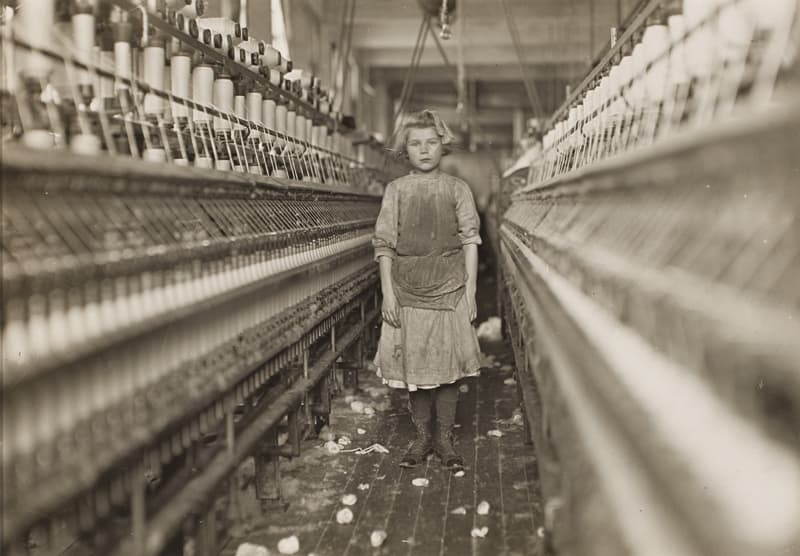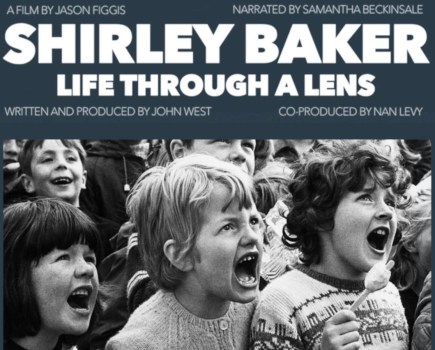Image: Young spinner in cotton mill, Georgia, USA, 1909. © Lewis Hine/George Eastman House/Getty Images
Lewis Hine was one of the great American documentary photographers. For him, the camera was a means by which he could highlight social problems, such as poverty, slum housing and child labour. Later, he used his camera to champion the positive contributions working people made to the economy. ‘There were two things I wanted to do,’ Hine famously remarked late in life. ‘I wanted to show the things that had to be corrected and I wanted to show the things that had to be appreciated.’
Hine was born in Wisconsin in 1874. As his father died when Hine was a teenager, he did a variety of low-paid jobs, including factory work, to help support the family. Later he studied sociology at the University of Chicago before teaching nature study and geography at New York’s Ethical Culture School.
While there, he was first encouraged to use photography as a teaching tool. He would take his students out to photograph the city, and afterwards encourage them to analyse the pictures and relate them to their work. Hine realised that photography had great potential as a means of documenting and drawing attention to social problems.
Hine’s first significant project, started in 1905, was to record the large numbers of immigrants who were then arriving at Ellis Island in New York Harbor to start a new life in America. These people were usually regarded as second-class citizens, but Hine’s respectful photographs captured their dignity, vulnerability and often their tentative hopes for the future.
Following on from this work, in 1908, Hine was employed by the National Child Labor Committee as a photographer and investigator. At this time in America, there were almost two million under-15s working in industrial jobs. There were no national laws to protect younger workers and any existing local laws were inadequate or ignored. It was Hine’s job to go into factories, coal mines and textile mills around the Eastern US states to gather evidence of child exploitation.
To gain access to factories, he pretended to be an insurance agent, fire inspector or bible salesman. When inside, he would quickly set up his 7x5in glass plate, tripod-mounted camera and photograph the children in their workplace. He would also take detailed notes about them to tell the story behind the picture.

Image: Young male miners, wearing their jackets and caps, with dirt on their faces, USA, c1910. © Lewis Hine/George Eastman House/Getty Images
One typical caption reads: ‘Furman Owens, 12 years old. Can’t read. Doesn’t know his ABCs. Said, “Yes I want to learn, but can’t when I work all the time.” Been in the mills 4 years, 3 years in the Olympia Mill. Columbia, South Carolina.’ Hine published two books on the subject in 1909, called Child Labor in the Carolinas and Day Laborers Before Their Time.
Hine amassed a large number of child labour images over an eight-year period. The children were photographed as he found them, and their blank, sad faces, often aged beyond their years, reflect a life of hard, monotonous work and little education.
In 1916, the US Congress agreed to pass the Keating-Owen Act, which placed national restrictions on the employment of children under 14 in factories and shops. The Act was later repealed as ‘unconstitutional’, but it was followed by state-level legislation that banned child labour. ‘The work Hine did for this reform was more responsible than all other efforts in bringing the need to public attention,’ wrote the chairman of the National Child Labour Committee.
At the end of the First World War, Hine began working for the Red Cross. He travelled to Europe and photographed Red Cross relief work, particularly among French and Belgian civilians who were affected by the war.
The 1920s saw the development of a new phase in Hine’s work, in which he campaigned for better safety laws for industrial workers. ‘I wanted to do something positive,’ he later wrote. ‘So I said to myself, “Why not do the worker at work? The man on the job? At the time, he was as underprivileged as the kids in the mill.”‘
These ‘work portraits’ showed industrial employees as making a contribution to the American economy and put the emphasis on man and machine working together. They were very different from Hine’s earlier child-labour work and one example, his famous ‘Steamfitter’ photograph (1920), showed the worker as a strong, heroic figure.
He continued this work for several years, taking on commissions such as documenting the building of the Empire State Building in 1930-31. The resulting study, Men at Work, is one of his best-known projects. During the Great Depression, he also photographed drought relief in the southern states of America for the Red Cross and was commissioned to photograph workers at the Shelton Looms textile factory.
In the late 1930s, Hine’s sporadic commissions from government and corporate bodies ended. He had always found it difficult to make a living from documentary photography, but now he got into serious financial difficulties.
In 1939, his mounting debts resulted in the loss of his home and he was reduced to applying for welfare assistance. The following year, he was admitted to New York’s Dobbs Ferry Hospital where he died after an operation, aged 66.
Since Hine’s death, he has become recognised as one of the pioneering documentary photographers of the 20th century. His extensive body of work gives us a fascinating insight into the appalling working and living conditions endured by millions – conditions that his photographs brought to public attention and ultimately helped to change.

Image: Lewis Hine, USA, c1930. © Lewis Hine/George Eastman House/Getty Images
Biography
- 1874: Lewis Wickes Hine born on 26 September in Oshkosh, Wisconsin, USA
- 1890-93: After his father’s death, he works in an upholstery factory and does various jobs, including door-to-door selling
- 1900: Studies sociology and pedagogy at the University of Chicago, followed by a teacher training course
- 1905: Begins photographing the social conditions endured by new immigrants to the US
- 1907: Commissioned to photograph the Pittsburgh iron and steel workers, and shows that children were employed in dangerous conditions
- 1908: Becomes the director of the photography department at the National Child Labor Committee in New York
- 1918-19: Works in Europe as a photographer for the American Red Cross
- 1921-30: Carries out a range of assignments for a variety of social welfare organisations
- 1930-31: Commissioned to photograph the construction of the Empire State Building
- 1932: Publishes Men at Work
- 1932-33: Photographs textile workers for Sheldon Looms
- 1939: Holds an exhibition at New York’s Riverside Museum, sponsored by well-known photographers including Alfred Stieglitz. In the same year, Hine’s financial problems result in him losing his home
- 1940: Dies in poverty on 3 November, aged 66
Books and websites
Books: Lewis Hine by Mary Panzer (part of the Phaidon 55 series) offers a succinct introduction to his work. For a more detailed study, see Lewis Hine by Alison Nordstrom and Elizabeth McCausland (published by Distributed Art Publishers).
Websites: An extensive collection of Hine’s photographs is available to view online at www.lewishinephotographs.com. More information on Hine’s life and photographic techniques can be found on www.notesonphotographs.org (search for ‘Lewis Hine’).







